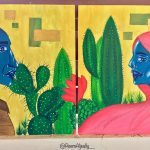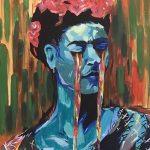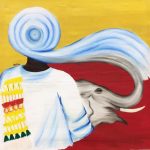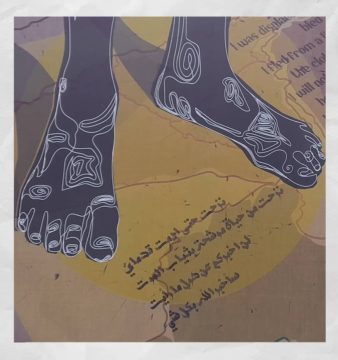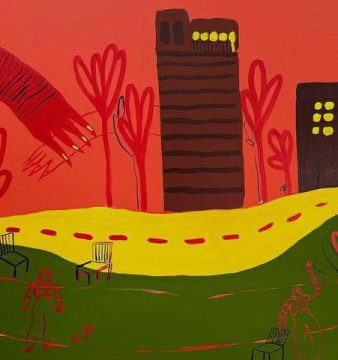In Conversation with Reem Al Jeally
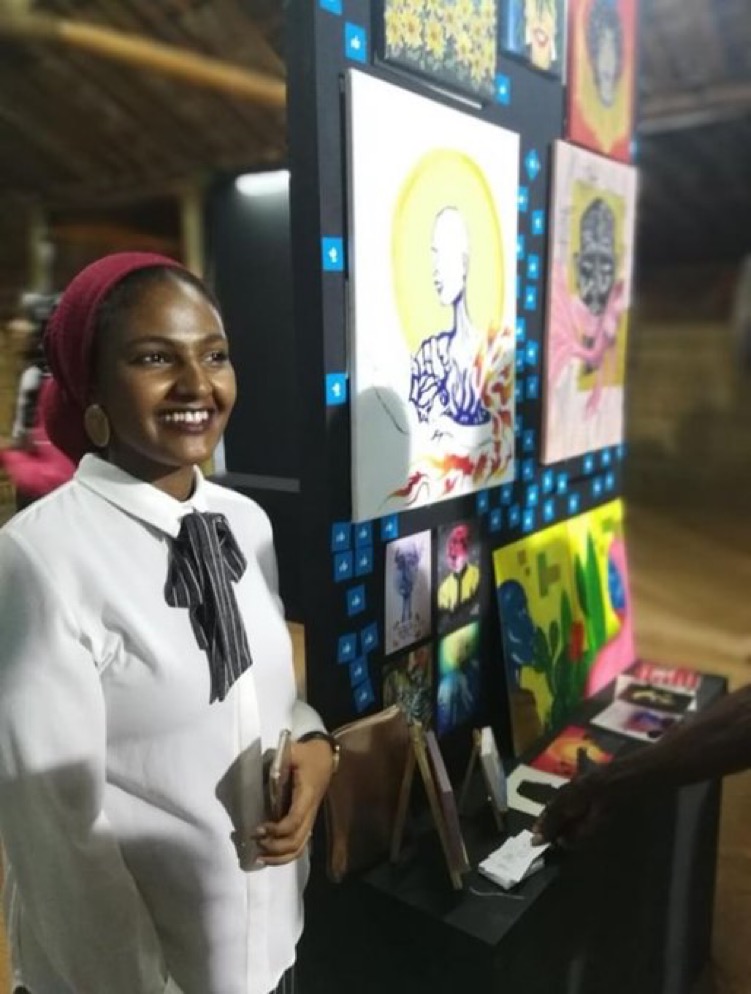 During the past few years, Sudan has witnessed a prominent revival of its ‘art scene’. A country of dense history and diverse ethnicity, Sudan has been a pioneer in the art world, sharing its numerous stories of triumphs and downfalls through music, literature, fashion, cuisines and paintings. Art is embodied in the lifestyle of a Sudanese, from their daily routines to their occasional events.
During the past few years, Sudan has witnessed a prominent revival of its ‘art scene’. A country of dense history and diverse ethnicity, Sudan has been a pioneer in the art world, sharing its numerous stories of triumphs and downfalls through music, literature, fashion, cuisines and paintings. Art is embodied in the lifestyle of a Sudanese, from their daily routines to their occasional events.
Theodore Dreiser; a novelist of the 20th century said, ‘Art is the stored honey of the human soul.’ It takes a specific type of aptitude and proficiency to translate art into still motion but artist Reem Saif Eldien Abd Elrazig Al Jeally has done exactly that.
Only 20 years old, Reem captured the attention of many with her bold use of colour and intriguing interpretation of reality. She has managed to produce exceptional and unique work. A recent graduate of the Faculty of Architecture from the University of Khartoum (UofK), she sought out to combine her education with her passion. She recently took part as an exhibitor or displayer at Bēhance Sudan 2018, a much-anticipated annual event in Sudan that showcases the work of artists of all forms in one platform.
500 Words Magazine sits in conversation with the rising artist Reem Al Jeally about her journey with art.
Tell us about your first art experience.
I started drawing at a very young age. I can’t remember a time of my life where art wasn’t involved. My first art experience started in elementary school. Every Thursday was ‘Activities Day’. The options ranged from sports to music to arts. I was immediately drawn to arts. I had quite the remarkable teacher. Mrs Shadia was always encouraging and pushing me into working with different mediums and textures. This helped expand my limitations and perception of art. Like Van Gogh said, ‘Be clearly aware of the stars and infinity on high. Then life seems almost enchanted after all.’
Did your upbringing prompt a specific reference point within your work?
My parents were always very supportive of my interests and hobbies. They always encouraged and helped me. My uncle lives in KSA and would always send me painting supplies and sketch books. I come from an artistic family. Most of my cousins are also painters or into fashion or music. So growing up amongst all this talent and encouragement had definitely made an impact on me.

Is your work informed by certain concepts or themes from your cultural heritage?
In 2016, I participated in a contest held by the Afro-Arab Cultural Institute. This contest was truly a defining moment for me. It was the moment when I was able to discover a lot about the type of art I want to keep making — art that reflected my perception of our culture. The painting I participated with in the contest was very personal to my family and I. It was of my grandmother. Like all grandparents, she is the backbone of our family. She is a major link to culture. I painted my grandmother dressed in the traditional garment, the “toab”, which integrates into a sea that embraces the entire family and carries us through all the wavy times. Though I use blue usually to represent sadness, I used it here to represent her purity. My dad named this painting “بحر العطاء”, which means “the sea of giving” and just like the name, my grandmother truly is an endless sea of giving.
After that contest, I found myself constantly questioning identity, and trying to understand it and figure out other ways I could express it. It took me about a whole year to finally figure some of it out. This resulted in my piece “Identity Collide”. It was my view on Sudanese identity, whether we’re Arabs or Africans, and how it’s entirely special being both. But I tend to like the African identity more.

What other moments do you feel contributed to your evolution as an artist?
Starting 2016 until this very day, I’ve had numerous great experiences that exposed me to an audience that appreciates what I do. I have started to establish a fan base. This certainly made me evolve as a painter and as an artist — from the contests I’ve participated in to my very first solo exhibition in December 2017 under the name “Lumos”. It was a Harry Potter themed gallery, as the movies and the books of Harry Potter are like a tradition in my family and an important memory from my childhood. The experience of the gallery made me more confident with what I am doing for I wasn’t sure at first if people would actually be interested in attending but the success of it surprised me.
What does your work aim to say?
Most of my work speaks of me and my interpretations of things, whether of my perception of such a large perspective as our culture or of much smaller matters. The combinations of these different images combine to form a picture that I try to translate into a canvas. Currently I am working on a new collection called “Character” that is based on this concept. I’m attempting to produce a collection that expresses deeper things than that of which are visible on the surface. The first one I’ve completed is called “Character 1”, this originated from a little sketch inspired by real features.
Does your work comment on current social or political issues?
As a novice artist, I haven’t yet progressed into the ever so controversial realm of social and political issues. I find myself still attempting to comprehend and grasp my basic understanding of life. Dabbing in the whimsical life that surrounds me, through my art I find myself experiencing life anew. Maybe in the future, as I progress and grasp things more, I might be able to shed light on social and political matters.
Do you feel like though you are missing an opportunity to join a broader conversation in the art world? Why?
I wouldn’t really say that I’m missing anything. I’m a firm believer one creates the opportunities for themselves. It isn’t really handed to you because nothing is ever really handed to anyone. The more I carry on painting, the more opportunities I create.
How are you developing a career in arts?
Developing my career is equivalent and paramount to developing into an artist. I joined an art association called “Arhectora”, which was founded by students from the university with the aim to broaden the art scene within the university itself. Being a part of them helped me a lot in improving my techniques and expanding my thoughts. Participating in contests and art fairs as well has definitely helped me showcase my work to a large audience and connect with a number of great people. I started a small business of handmade covers to help myself financially. It was mainly to help with the expenses of the preparations to my first art gallery, but to my surprise it was met with great acceptance so I kept it going.
How do you seek out opportunities?
Through social media, I have managed to spread my work and cultivate a fine collector base, and by being a part of youth related fairs like the British Council’s #YouthQuake event in February 2018 and Bēhance Sudan in October 2018.
Can you tell us about your painting process? What are your favourite tools for painting?
When it comes to comes to my paintings, I always start off my paintings as sketches then work my way with paint. You’ll notice my unconventional use of colours, which represent certain feelings I try to convey to the viewers. I tried a various number of mediums and techniques in my work from pencils and markers to acrylics and oils and even glass colours but have found that my brushes are the most important things to me. Choosing the right brush makes all the difference. When I pick up the brush, I’m immediately swept into a different world filled with vivid colours and dynamic compositions.
How do you price your work?
When it comes to the thorny job of pricing my work; considering the wavy economic state, I try to make my art affordable and in reach. Depending on the size of the canvas, type of paint and the effort put into the final work, I reach a final pricing.
Which current art world trends are you following?
I’m a huge admirer of both Expressionism and Surrealism. Expressionism is an art movement that began in the 20th century in Germany, purely driven by the desire to express emotion. Surrealism, also a 20th century movement, seeks to release the creative potential of the unconscious mind. This results in the illogical combination of images. Alberto Giacometti said, ‘The object of art is not to reproduce reality, but to create a reality of the same intensity.’
Who are your biggest art influencers both locally and globally?
I’m fascinated by the works of Frida Kahlo and Van Gogh. They both have such powerful ways of translating their painful experiences on canvases. I find myself quite drawn to their stories. Seeing their raw emotions drawn out for everyone to see, I find this quite powerful, to be able to paint ones pain in such an articulate and precise way. One of my life’s dreams is to visit the Van Gogh Museum in Amsterdam.
I also find myself drawn to Ibrahim El Salahi. He is an advocate of the Hurufiyya movement, which combines traditional graphic forms into contemporary art works. He has not only succeeded to make a name for himself locally but has managed to capture the attention of many on an international scale as well. I admire his persistence and boldness very much. One day, I hope to reach that level as well.
Dar AlNaim, Assil Diab and Hazim El Hussein are just a few more names of Sudanese artists that have unique sensational styles.
What are your thoughts on the art scene in Sudan?
For a long time, the art scene in Sudan was non-existent. Art was considered a waste of time. People have neglected themselves alongside our traditions and became absorbed in a repetitive tasteless life. Unlike before where Sudanese constantly celebrated life in all its forms and appreciated the art of it. This was during what was known as the “Golden Sixties”. Recently, the art scene has been growing and it’s much easier for beginners to develop their talents and enhance their techniques. Art has gained its independence and has become of value again. Of course we face the problem of buying tools with the ongoing economic struggle in the country and the issue of finding things in good quality. But mainly the acceptance is growing to all the forms of art that are being presented by different artists.
What do you feel like your work is contributing to the current art world in Sudan?
Every artist has something to contribute; whether large or small. By sharing these moments with the world, they add a new voice to the art scene. Just like these artists, I’m adding my style and journey through the stories I share. I feel as though I’m just in the beginning of my art journey and discovering myself. I have yet a road to pave to reach a position where I can contribute more work in my style and hopefully influence more people to speak out through art.
What advice can you give people?
The best advice I can give anyone is in two quotes that I feel has all the answers.
‘I am seeking. I am striving. I am in it with all my heart.’ – Vincent Van Gogh
This quote I feel relates to everything in life. What you want to do, whatever it maybe whether art or anything else, invest yourself in it.
The other quote encourages me during my blank moments, and I hope it does the same to everyone else.
‘Whether you succeed or not is irrelevant, there is no such thing. Making your unknown known is the important thing.’ – Georgia O’Keeffe
For more information on Reem Al Jeally, find her on Twitter or Instagram @ReemAljeally.
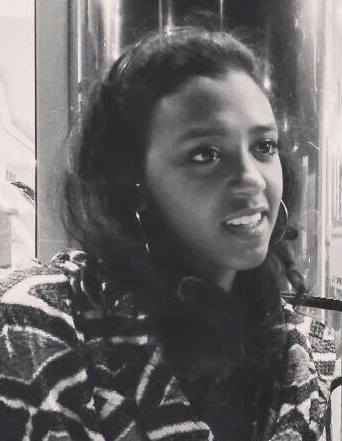 Hadeel Mohamed Hamid is a 23-year-old recent graduate of the University of Khartoum – Faculty of Architecture. She is an extreme believer of the importance of culture and tradition in forming and developing a country’s identity. Exploring writing for the first time, Hadeel will delve in topics of society, culture and architecture as well as writing about her own personal experiences growing up as millennial in Sudan.
Hadeel Mohamed Hamid is a 23-year-old recent graduate of the University of Khartoum – Faculty of Architecture. She is an extreme believer of the importance of culture and tradition in forming and developing a country’s identity. Exploring writing for the first time, Hadeel will delve in topics of society, culture and architecture as well as writing about her own personal experiences growing up as millennial in Sudan.

